If you are looking to open up your own dental office, many things need to be considered. This article will help you learn more about the process of opening a dental practice and what steps it takes to get started. Find out how much money should be invested in starting your own business, as well as what legal requirements must be met before opening for business. You’ll also find information on how much competition there is in the industry so that if this does not seem like the right career path, you can make an informed decision about where else to look.
1. Pick a location for your office
Dental offices can be located in a wide variety of places. When choosing a location, the most important factor is to find an area that does not have many other dental practices near you because this will increase the chances of your practice succeeding. However, if there are few surrounding businesses, it may make finding new patients harder. If you decide to open up shop next door to another dentist, be sure they won’t mind, or else potential customers might get confused and visit both offices! It’s also helpful if the region has good public transportation, so people without cars don’t have trouble getting to your office for appointments. Another thing to think about is what areas would yield more business than others based on population demographics and city plans. Just keep in mind that cities may change their plans, and not all areas will be as profitable as originally thought.
2. Register with the Dental Board of California
Before you can even open your office, you must register with the Dental Board of California and receive a license to practice. Damon Becnel says this is necessary because all patients will know that they are receiving care from an actual dentist and not just someone who claims to be one. It also protects people if anything goes wrong while visiting the office or if any legal action needs to be taken against them by other businesses such as insurance companies.
The application process takes about three months to complete, so plan! You’ll need plenty of forms filled out, including financial records, proof of citizenship status (if applying), two passport-sized photos on top of everything else. It is best to hire an attorney who specializes in this kind of thing so they can help you through the process and make sure nothing gets missed; plus it will cost less than trying to do all of this on your own.
To complete the application fee, be paid by check or money order payable to “Dental Board” along with a $250 filing fee that will go towards processing fees upon acceptance into the program. If accepted, another payment for registration costs must also be completed, which includes two more annual licenses for board members and one license each year after that until office closure occurs (for instance, if you decide not to continue running your business). You’ll need additional credentials before obtaining a dental permit from California’s Dental Law Office.
3. Find an office space that meets your budget and needs
Once you have registered with the Dental Board of California, you are free to begin finding an office space that will be suitable for your needs. Keep in mind how much money you can afford to spend on rent and other expenses while searching around- it may take time before new patients start coming in, so try not to stress about this too much if necessary!
If possible, choose a location with plenty of parking nearby because some customers may be hesitant to visit if they think street parking might be difficult or unsafe. You’ll also want close access to public transportation, especially since most potential clients probably don’t own cars. If possible, find an area with high foot traffic where people naturally come by often, whether it’s just down the road from a local park or around a fast-food restaurant.
If you plan on using the office only part of the time, leasing out space to other dentists might be your best bet if it is one big open area- this will help pay off expenses and provide some extra cash flow which can always come in handy!
4. Hire employees to help you run the business smoothly
After your office is equipped with chairs and other necessities, it’s time to find employees to help get this business up and running. Although you might be tempted to do everything yourself out of fear or laziness, hiring a few professionals in key areas such as marketing/advertising, receptionist services, dental assistance/hygienists, etc., can boost productivity while freeing up more time for yourself!
It doesn’t have to cost much either- there are plenty of paid online forums where potential candidates post their resumes, so this could be an effective way of finding the right people who fit within your budget. Make sure they all bring something unique to the table, so no one feels underutilized or useless, which would ultimately lead them to look elsewhere for employment if possible.
5. Purchase equipment like dental chairs, x-ray machines, and sterilizers
After you have hired the right employees, it’s time to buy some equipment for your office. You can find these items online or in physical stores such as Walmart and Target- just make sure they are FDA approved, so all medication is safe from infection!
If possible, ask former dentist friends of yours if they would be willing to purchase a few new supplies on behalf of your business at a reduced cost or even free since you will soon become their client as well. Dentists often have extra stock lying around that needs to be sold but may not want to advertise due to lack of time/money, which works out perfectly for those who need them most!
6. Market your practice to potential patients to get new clients
Now that your business is off the ground and running, it’s time to market it! This is probably the most important step in this process because, without customers, there will be no money coming in, which means you may as well close down.
There are plenty of ways to get potential patients into your office. You can create an online presence via social media sites such as Facebook or Twitter can help with networking. Having patients share between friends and family members (which would increase foot traffic). Local newspapers and magazines often provide free ads for small businesses like yours, so take advantage since they already have a large built-in audience. If you live near a college campus where young adults tend to congregate, advertising itself might help you get more traffic as well.
In conclusion, this article provides a few tips to help guide you in the right direction when thinking about opening your own dental office. Although it might seem like an impossible task, there are plenty of ways around this dilemma that can ultimately benefit everyone involved!

